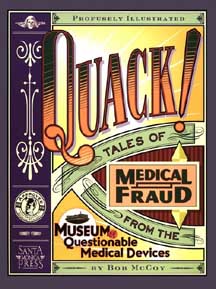
Phlebotomy: The Ancient
Art of Bloodletting
By Graham Ford
 The
practice of bloodletting seemed logical when the foundation of
all medical treatment was based on the four body humors: blood,
phlegm, yellow bile, and black bile. Health was thought to be
restored by purging, starving, vomiting or bloodletting. The
practice of bloodletting seemed logical when the foundation of
all medical treatment was based on the four body humors: blood,
phlegm, yellow bile, and black bile. Health was thought to be
restored by purging, starving, vomiting or bloodletting.
The art of bloodletting was flourishing well before Hippocrates
in the fifth century B.C. By the middle ages, both surgeons and
barbers were specializing in this bloody practice. Barbers advertised
with a red (for blood) and white (for tourniquet) striped pole.
The pole itself represented the stick squeezed by the patient
to dilate the veins.
Bloodletting came to the U. S. on the Mayflower. The practice
reached unbelievable heights in the 18th and early 19th centuries.
The first U.S. president, George
Washington, died from a throat infection in 1799 after being
drained of nine pints of blood within 24 hours. The draining
of 16-30 ounces (one to four pints) of blood was typical. Blood
was often caught in a shallow bowl. When the patient became faint,
the "treatment" was stopped. Bleeding was often encouraged
over large areas of the body by multiple incisions. By the end
of the 19th century (1875-1900), phlebotomy was declared quackery.
A variety of devices were used to draw blood:
- The lancet was first used before 5th Century B.C. The vein
was manually perforated by the practitioner. Many shallow cuts
were sometimes made.

Spring loaded lancet
- Spring loaded lancets came into use during the early 18th
Century. The device was cocked and a "trigger" fired
the spring-driven blade into the vein.
- The fleam was heavily used during the 18th and 19th centuries.
Many varieties exist. Sometimes a wooden "fleam stick"
was used to hit the back of the blade and drive it into the vein.
(Ouch!) The fleam was often used by veterinarians.

Scarificator
- The scarificator, a series of twelve blades, was also in
vogue during the 18th Century, This device was cocked and the
trigger released spring-driven rotary blades which caused many
shallow cuts. The scarificator seems more merciful than the other
blood-letting instruments.
Blood was caught in shallow bowls. During the 17th to 19th
centuries, blood was also captured in small flint glass cups.
Heated air inside the cups created a vacuum causing blood to
flow into the cup - a handy technique for drawing blood from
a localized area. This practice was called cupping.
Flint cup

The data above is based on Antique Medical
Instuments by C. Keith Wilbur, M.D. (1987). For more details,
see Bloodletting Instruments by A. Davis and T. Appel
(1983).
Graphics from the Truax, Green & Co.
(Chicago) Price List: Spring Lancet #5125. $.70; Scarificator
#5126, $3.25; and Plan Glass Cupper #5142, $.08.
ONLINE INFORMATION:
The UCLA Biomedical Library has a multi-page exhibit on
bloodletting
including graphics
of bloodletting devices. Bloodletting
Antiques by Douglas Arbittier, M.D. features fast-loading
thumbnails of devices, leach bowls and cupping sets. For other
ancient devices, see Greek
and Roman Surgical Instruments, part of the Asclepion,
a University of Indiana site devoted to the study of ancient
medicine.
HISTORY OF BLOODLETTING
And YES there are people who still practice Phlebotomy! - Phlebotomy.com
 * *
 previous next previous next

Watch clips of curator Bob McCoy's
many television appearances in our:
Video Vault!
See the Quackery items available in our Gift Shop
HOME| INDEX | DEVICES | VIDEO | GIFT SHOP
QUACKS | EPHEMERA | LINKS|

"A stunning testament to the myriad of ways people have tried to make money off the eternal ills of humankind." -New York Times
"Snake oil salesmen, beware!" - Time Magazine
"An assortment of medical devices that will at once amaze, entertain, and inform you!"
-Late Night With David Letterman
 Amazon.com Rating Amazon.com Rating
|
Quack!
Tales of Medical Fraud from
the Museum of Questionable Medical Devices
by Bob McCoy, Curator
The curator of the Museum of Questionable Medical Devices shares his collection of the hilarious, horrifying, and preposterous medical devices that have been foisted upon the public in their quest for good health. Includes the Prostate Gland Warmer, Phrenology Machine, Recto Rotor, Nose Straightener, Wonder Electro Marvel, and hundreds of other quack devices. With period advertisements, promotional literature, and gadget instructions, this book offers a wealth of past-and-present medical fraud.
Available at Amazon.com
|
Museum of Questionable Medical
Devices
http://www.museumofquackery.com/devices/phlebo.htm
updated 6/13/15
|

